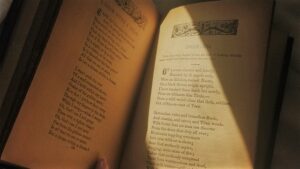
Literature is any collection of written work which may include art form. Poetry, drama, novel, fiction, prose, etc come under the definition of literature. But in the current era, modern technology has altered the shapes of almost everything. The advent of technology has affected literature as well. A lot of literature has been published online and it is still counting. Modern literature is very famous in developed societies.
In fact, literature is a method in which knowledge and entertainment are designed, transcripted, and preserved. Modern literature has a deep impact on social formation in any society. It will not be wrong to say that it shapes social norms and values.
What Is Literature?
As any writer or reader will tell you, a book or other work of literature is not something you can “own” or understand apart from the reader’s experience. And while a good book can open up a world of possibilities for its readers. It can also be a bit difficult, challenging, sometimes even downright agonizing. If you’ve ever found yourself in that “wilderness” of a book, you might have appreciated, with good reason, Carl Sagan’s view that “mysterious is an indispensable ingredient of literature.
The Meaning And Forms of Modern Literary Genres
Modern literary genres such as the novel, poetry, and drama emerged in the Late Middle Ages, at the close of the Late Middle Ages. They have a long history in Western Europe. Where there were originally separate genres of poetry (and prose). But each genre developed its own distinctive style and language over time. Modern literature is very popular in western societies.
Poetry was the earliest developed form of literature, probably in an oral form of communicating religious themes. Chaucer (1340–1400) is generally seen as the most important poet of the High Middle Ages. But his work was not especially long. There were other English poets working in the mid-to-late-14th century. For example Edmund Spenser and Thomas Nashe, but none of their works survive.
Prose Fiction
The common classifications of fiction have long been tied to the outline of narrative genres. Classical theory regarded the three standard genres of comedy, tragedy, and romance as encompassing a distinct literary form or “fashion” that developed over time. Some have also considered another standard form of fiction, the roman noir, a major influence on American hardboiled noir writing in the 1920s. However, the overarching term for fiction is simply “fiction,” and it is common to have many sub-genres within any given type.
Many prose novels can be classified by theme or plot; a lot of science fiction and fantasy stories also use fantasy conventions. Some storytellers limit themselves to one genre or one particular sub-genre.
Drama
Drama is a type of performance, usually comic, enacted between the form of a pre-existing oral tradition and the visual media. This is distinct from its visual counterpart, which may be a painting, a statue, or a still image.
Literary Criticism
Literary criticism is the study of literary works and their authors. Its purpose is to draw attention to the author’s artistic skills, historical, social, philosophical, or spiritual considerations. It can also analyze the differences between literary works of high and low quality. It explains how a work should be judged. Literary criticism is a part of the discipline of literature. and is practiced in fields as different as professional education, psychology, law, and medicine.
Poetry
A poem is a verse form of poetry, which involves rhyming couplets that have a fixed number of lines. But many different syllables, and ideally a meter. The first line typically repeats the line it precedes, but only once, with the two others in between. This rhyming pattern of “ABABCC…”, where “A” has one syllable, “B” has two, and “C” has three, is referred to as a metre or stanza. Lyrics for songs or poems have one or more rhymes and one or more syllables in each line.
Poetry may be represented in the form of free verse or anionic verse. Where the syllables are arranged without rhyme or meter. Most poetry uses antonyms to express beauty, sadness, anger, and other strong emotions.
Non-Fiction Genres
Writing that attempts to synthesize the knowledge and experience of others, often a collection of observations or case studies that draw conclusions from that data.
History
Genres
The genre of history seeks to present the story of the world and its people. It seeks in such a way that others can learn from its mistakes and successes. It seeks to present the story of the world and its people in such a way that others can learn from its mistakes and successes.
Fiction consists of the thoughts, ideas, and behaviors of living creatures, such as humans. It may include language, prose, poetry, and plays. Fiction provides a heightened level of perception through imagination and typically depicts fantasy and drama.
Biography
A biography, also known as a biographical novel, is a type of story-based literary work that attempts to relate the life of an individual to that person’s achievements and activities. The term biography can be used to describe a narrative, non-fiction piece, a collection of anecdotes and quotations, an account of a particular period of a person’s life, or a dramatization. Although the vast majority of biographies are written for the general public. And these are intended for a mass market. A biography can also be a highly researched work used as a vehicle for a highbrow audience.
This form of fiction can either have a first-person narrator, or a third-person narrative, or a combination of the two. Both of which are called biographical novels or biography novels.
Memoir
The name memoir comes from the Greek mémoire meaning “memory,” and refers to the first of two historical information-sharing genres. The second is a biography, which is “a long narrative of a person or group of people’s lives.” These two genres are basically the same, with one major difference. While the primary objective of a memoir is to tell the story of a person or group. The primary objective of a biography is to explain the facts of that person’s life to others. There are two main reasons for this difference: “the more simply it explains the facts, the more reliable it is judged to be.”1 The story of an individual’s life can be told in many ways, and memoirs must specify, clarify, and expand on these facts, for this is what the reader is interested in.
Letters
The importance of letters is highly recognized in modern literature Letters are written pieces of paper used for the transmission of information through writing. In the U.S., “letters” are usually spoken, though some types of letters have changed over time. After the Civil War, there was a proliferation of Civil War letters as soldiers sent back their impressions of life in the army. They also began to include personal letters between siblings and families.
Letters differ from journal entries in that journal entries do not maintain a record of a record, and thus letters are a record of events and the thoughts that led to those events.
Essays
Many of the essays written for literary journals are considered to be “literature.”. An essay is a collection of usually non-fictional prose, which provides a well-informed, often personal, report or analysis on a particular subject. The English word “essay” originally meant a one-page piece of writing of analysis in Latin (prosopon), where it meant “a paragraph.” This past participle of the verb esser, which means to measure, and to delineate, originally indicated a single paragraph or measure. In English, a single word conveying a single paragraph or measure would be called a pro-prose. (See also “Is art fiction?”)
Aristotle believed that writing about the dissection of corpses was a scholarly exercise, whereas writing for pleasure was unserious.
Non-Literary Genres
Many of us still know, from childhood, how to read a poem or picture book, or how to tell a good story. But even though those forms of literary expression and experience have been cultivated in large part by and for a literate society, some people have learned the other arts without formal training. Many of the other forms of writing are considered by many to be products of the oral tradition.
We know that George Washington was a learned man, well-read and avidly cultivated in literature and culture. But we also know that he was not a writer. We know that he did not compose long, intellectual essays, but instead, on occasion, composed letters or old-fashioned statements that could have come straight from the mouth of the Founding Father.
Non-Fictional Books, Articles, or Printed Information on a Subject
An article, particularly a non-fiction book, generally has one author. However, certain literary forms may have many authors, depending on the context, such as the history book, which may have numerous authors. Some works, such as a biography, don’t have a single author, but some biographies written in narrative form do have multiple authors, depending on the cultural background. In historical fiction, authors have more or less free rein to invent alternate history versions of the life of a real historical figure.
Non-fiction books or articles are often compiled of various components, including a few significant quotations, information, facts, and narrative of the events described.
The Bottom Line
In this article, I have tried to explain the concept of literature and modern literature. Modern literature evolved from the existing literature. In fact, it is more sophisticated, organized, and penetrating in society. A complete overview has been given about the literature. You will also see how these concepts can help you think about literature, poetry, and other artistic expressions.



Pingback: What is Poetry and How to Write It: A Guide for Beginners - Kitab Center
Pingback: The Impact of Technology on Literature: Is Modernity Ruining Our Favorite Form of Entertainment? - Kitab Center
Pingback: What is a Novel? Types of Novels, and What Makes a Good One - Kitab Center
Pingback: A Discussion on the Differences Between Prose and Poetry - Kitab Center